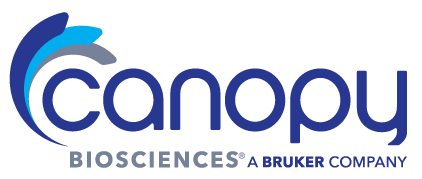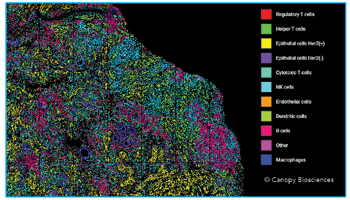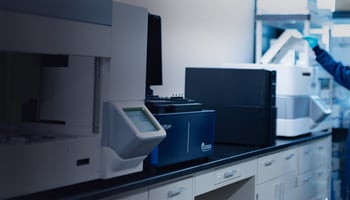Immune cell phenotyping is an important capability for immunology and immuno-oncology research,...
Software Options Available for Spatial Analysis
Advanced data analysis for spatial biology: What are the best options available?
CellScape and Enable Medicine: What is Enable Medicine?
In the dynamic landscape of medical research, the fusion of robust data analysis capabilities with advanced spatial biology imaging is revolutionizing scientific approaches. CellScape™ Precise Spatial Multiplexing and Enable Medicine, two spatial analysis platforms, have joined forces to provide a unique synergy that propels your research! CellScape offers state-of-the-art multiplex fluorescence imaging capabilities, while Enable Medicine serves as a powerful data analysis hub. When paired, these platforms seamlessly integrate data analysis, maximizing research insights and streamlining our ability to unravel complex biological processes.
CellScape, our cyclic immunofluorescence imaging platform, enables the visualization of complex tissue samples and accurate mapping of cell populations with single-cell resolution. The key features of CellScape include:
· Versatile Sample Compatibility: CellScape supports any sample type, including fresh-frozen and FFPE archived tissues, cell suspensions, and blood samples from both human and animal sources.
· Flexible Antibody Choice: Use any quenchable fluorescently labeled antibody—no conjugations or additional validation steps required.
· Walkaway Automation: Cyclic staining, imaging, and signal removal steps are all completed in microfluidic chips within the instrument for analysis of up to four samples simultaneously.
· Deep Phenotyping and Biomarker Profiling: Using highly multiplexed biomarkers, CellScape enables deep phenotyping of immune cells and classification of cell phenotypes. The high dynamic range (HDR) imaging feature captures signal intensities spanning 6 orders of magnitude, enabling gating strategies based on quantitative biomarker expression levels.
· Standard Image Outputs and Integration with Enable Medicine: CellScape provides imaging data in standard OME-TIFF format for seamless integration with the data analysis capabilities of Enable Medicine
Many analysis platforms are purpose-built to derive meaningful insights from complex datasets. Pairing cutting-edge imaging techniques with open-source machine learning algorithms, researchers can delve deeper into their spatial data to discover rare cell types, identify cell-cell interactions, and monitor disease progression or treatment efficacy in situ. Here, we describe various sophisticated data analysis platforms available for exploratory and translational research.
1. Visualizing Whole Slide Imaging: QuPath
QuPath is a powerful platform that allows researchers to visualize whole slide images in a convenient manner. Using pyramidal TIFF (tiled image pyramid), QuPath enables seamless navigation and analysis of high-resolution histopathology images. Its user-friendly interface and versatile tools make it an asset for researchers working with whole slide imaging.
2. Cell Segmentation: Open-Source Machine Learning Algorithms
Stardist
Stardist is an open-source software that utilizes deep learning for cell segmentation. It is compatible with various other analysis platforms, including the CellScape App, QuPath, and Enable Medicine. Stardist excels in accurately segmenting cells within images.
Cell Pose
Cell Pose, integrated with QuPath, is another powerful tool for cell segmentation. It employs deep learning to accurately detect and segment cells in diverse biological images.
DeepCell
DeepCell is a machine learning algorithm integrated with Enable Medicine, specializing in cell segmentation. A versatile tool that enables precise segmentation of cells from complex imaging data, DeepCell supports in-depth single-cell analysis.
3. Training Custom Algorithms: Indica Labs Halo and VisioPharm
Indica Labs Halo
Indica Labs Halo provides the flexibility to train custom machine learning algorithms. Researchers can tailor algorithms to specific datasets and research objectives, enhancing the accuracy and relevance of segmentation and analysis.
VisioPharm
VisioPharm is another platform that allows researchers to train custom algorithms for precise segmentation and analysis. Its customizable approach empowers researchers to fine-tune algorithms according to their specific research needs.
4. Quantification of Fluorescence: Various Platforms
Quantifying fluorescence is a critical step in many medical research projects. Multiple platforms offer comparable functionalities for fluorescence quantification, providing researchers with options to choose based on their preferences and workflow requirements.
5. Cell Type Identification: Bivariate Gating and Unsupervised Clustering
Bivariate Gating
Bivariate gating, available in both the CellScape App and Enable Medicine, enables researchers to phenotype cells based on biomarker expression patterns. This technique allows for targeted cell classification and deep immune profiling.
Unsupervised Clustering
Unsupervised clustering, offered by platforms like Enable Medicine and VisioPharm, allows researchers to identify cell types without predefined criteria. It groups cells based on biomarker expression patterns, providing an unbiased alternative approach to cell type identification.
Enable Medicine: A Hub for Data Analysis
So what does Enable Medicine do, you might be asking? Enable Medicine acts as a central portal, streamlining the data analysis process for researchers and leveraging Amazon Web Services (AWS) for efficient data processing. Key features of Enable Medicine BIOS include:
Efficient Access and Streamlined Analysis: Accessible via web browsers, Enable Medicine offers a user-friendly interface, permitting researchers to perform advanced analyses without extensive coding knowledge or computing capabilities. This accessibility democratizes access to analytical tools.
Sophisticated Segmentation and Phenotyping: The Enable Medicine BIOS suite provides multiple segmentation methods, including Stardist and DeepCell's AI-trained algorithm, allowing precise cell delineation. Researchers can phenotype cells, classify cell types, and identify subtypes, enhancing the depth of analysis.
Exploring Tissue Architecture and Cell Interactions: Advanced analyses, such as k-means clustering, enable researchers to examine spatial neighborhoods of cells and understand tissue architecture changes. The platform's Explorer feature allows for diverse visualizations, enhancing the exploration of cell-cell interactions and tumor microenvironments.
Community Collaboration and Data Sharing: Enable Medicine facilitates collaboration and data sharing within the research community, fostering a collaborative environment that accelerates scientific progress.
The seamless integration of data from CellScape into the Enable Medicine cloud platform represents a significant advancement in biological research. By marrying advanced data analysis capabilities with high-resolution immunofluorescence imaging, researchers can overcome the largest hurdle of spatial biology: data processing. This integration also fosters cross-site collaboration and accelerates progress by removing the need for local computational capabilities. Together, CellScape and Enable Medicine embody the future of biomedical research, facilitating a transformative understanding of biology and driving precision medicine.



